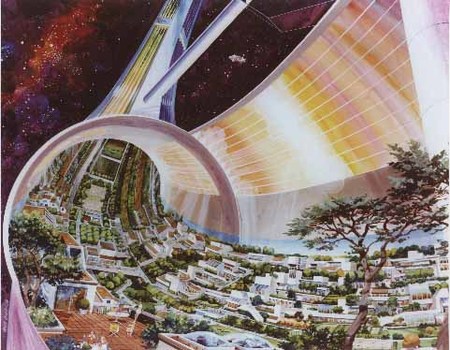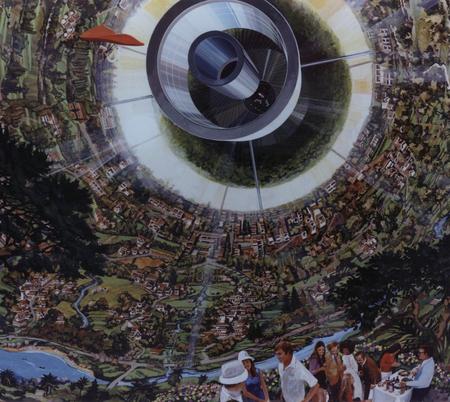I recently finished listening to all of the fascinating lectures in the Silicon Valley Astronomy Lectures series of podcasts. I highly recommend these lectures to anyone that has an interest in astronomy and space exploration. I expected these lectures to be very dry, technical, and boring, but for the most part they were very engaging and directed towards the general public in understandable language. There were some forays into overly obscure technical topics, but overall, the speakers kept things very understandable. And some of them have cool-sounding names, like FRACK-NOY and CROOK-SHANK. The main thing that kept me interested throughout the lectures was feeling the connection to the speakers’ excitement over new space-related discoveries and possibilities. There are just so many awesome space missions going on right now. I felt like a kid again, poring through library books about space, marveling at the explorations of the universe. Yet, it is already 2008 and there are STILL no space colonies (ISS doesn’t count), despite the ambitious claims made by most of the space books from my youth. This cuts me deep. Real deep. *Sniff*.


Oh, groovy 1970s artist renditions of space colonies, why did you never become real?
Nevertheless, the topics of current research and exploration were very interesting. Some examples:
- The New Horizons mission to visit Pluto. It launched in 2006, and was the FASTEST object we ever launched from our planet (the craft only took 9 hours to get to the moon!). Even so, it won’t get to Pluto until the year 2015, but it has already visited Jupiter. While there, the craft made this incredible animation of an active volcano on Jupiter’s moon Io. And this cool montage of Jupiter and Io:

Jupiter-Io Montage from New Horizons. Click for a larger view (take a look especially at the big volcanic plume and glowing-red lava of Io). See an even closer view of the volcanic region by clicking here for a picture taken during the Galileo mission.
Seven years is a long time to wait to see close-up pictures of Pluto. Should be pretty exciting when it happens! Mission scientists also expect to discover new objects in the Kuiper Belt, a distant region of our solar system with interesting remnants of its birth. Check out this illustration which includes several known Kuiper Belt objects.
- Many scientists on Earth make discoveries by breaking things. Biologists can dissect animals, geologists can break apart rocks, physicists can smash particles together. But astronomers have to settle for only being able to look at things from a vast distance. Look, but don’t touch! So this is why astronomers were extremely excited when Comet Shoemaker-Levy 9 smashed into Jupiter in 1994. Yay, we can see stuff break to find out how it works!

Impact site of one of the comet fragments. Ow! My atmosphere!
- When we look at distant galaxies, we discover that the universe is expanding. Under physical laws, we expect that these heavy objects will slow down in their expansion over time, due to gravitational effects they have on each other. For example, when you throw a ball straight up into their air, it will eventually slow down and come back towards you. But the expansion of the universe isn’t slowing down. It’s getting faster. The ball is continuing to go up into the air, moving faster and faster, and isn’t coming back down. What the hell is going on??? There isn’t even enough so-called dark matter to account for this — there is a new hypothesis that “dark energy” is causing the acceleration of the expansion of the universe. This stuff hurts my pathetic brain. All I can think about is the classic pepper and soap experiment where the pepper rushes almost instantaneously away from the soap due to changes in the surface tension of the water.
- Dr. David Morrison discussed the possibility of Earth being impacted by a large enough asteroid to cause mass extiction, an event strongly believed to have happened at least once in Earth’s history. The Alvarez hypothesis theorizes that an asteroid wiped out the dinosaurs long ago. This theory is very strong because sediment layers (which act as geologic time capsules) taken from the ocean from many different locations all show the same abnormal concentration of Iridium. Iridium is very rare in Earth’s crust but is very common in asteroids. This, plus other material found in the samples, strongly suggest that the dinosaurs and many other species were snuffed out by a bigass rock from space. Luckily, there is a NASA program busily surveying the skies for near-earth asteroids to discover them before they interfere with our ability to kill each other and watch reality TV shows.
- As of this month, there are 271 planets that are known to exist beyond our solar system. We’ve made most of these discoveries in only the last dozen years. Almost 300 planets in just 12 years. Before twelve years ago, we suspected a large number of planets, but we had no direct evidence. This is just the tip of the iceberg – astronomers believe that MOST stars that we can see are orbited by planets. We currently have a lot of trouble finding the smaller, Earth-sized planets, since they are so far away, and so small relative to their stars. But there are several exciting upcoming missions that will learn more about planets outside our solar system: SOFIA (a jumbo jet with a big infrared telescope sticking out of an open door), the Kepler mission (a space-based telescope whose top priority is to find “other Earths” — it is scheduled to launch just next year!), and the Space Interferometry Mission (a.k.a. Sim PlanetQuest; this mission is also designed to locate Earth-like planets). Over our lifetimes, we can expect a lot of new, amazing discoveries.

Artist rendition of “Earth-like” planet we hope to discover with one of these missions. I hope “Earth-like” doesn’t mean “also populated by fans of reality TV shows”.
-
The Hubble Space Telescope, despite its early (and corrected) near-sightedness (see here for a nice before-and-after), continues to generate loads of important data and discoveries. Not only does it make awesome pictures to hang on your wall next to your Pink Floyd and Grateful Dead posters, but it can also look backwards in time! One of the most amazing things astronomers did with Hubble was point it at a tiny piece of seemingly empty sky, devoid of stars (“roughly one thirteen-millionth of the total area of the sky”), and “left the exposure on” for over eleven days to capture the tiny amount of light coming from that tiny piece of sky. The result was the “Hubble Ultra Deep Field”, an image showing around 10,000 galaxies. It makes me think of looking at a tiny drop of water under a microscope, and finding it teeming with tiny microbial life. The galaxies are so distant that the light has taken 13 billion years to reach Hubble; this means the image is a snapshot of those galaxies as they were 13 billion years ago, when our universe was only a billion years old. It is amazing to me that we can time travel this easily just by looking into the sky.
“The past does not exist. There are only infinite renderings of it.”
– Ryszard Kapuscinski, in his book Travels With Herodotus.Maybe if we keep looking, we’ll eventually see a reflection of a permutation of ourselves, distorted in the endless funhouse mirrors we continue to find as we peer in our vast universe…
Go forth and listen to the lectures for more amazing topics!
P.S.: Here is a bad physics joke told during one of the lectures:
Heisenberg’s uncertainty principle, developed in 1927, states that the simultaneous determination of two paired quantities, for example the position and momentum of a particle, has an unavoidable uncertainty. Some people suspect that when he came up with this principle, Heisenberg may have been having problems with his love life: When he had the time, he didn’t have the energy. And when he had the position, he didn’t have the momentum.

Pingback: oranchak.com » Blog Archive » More astronomologicalful podcastiness